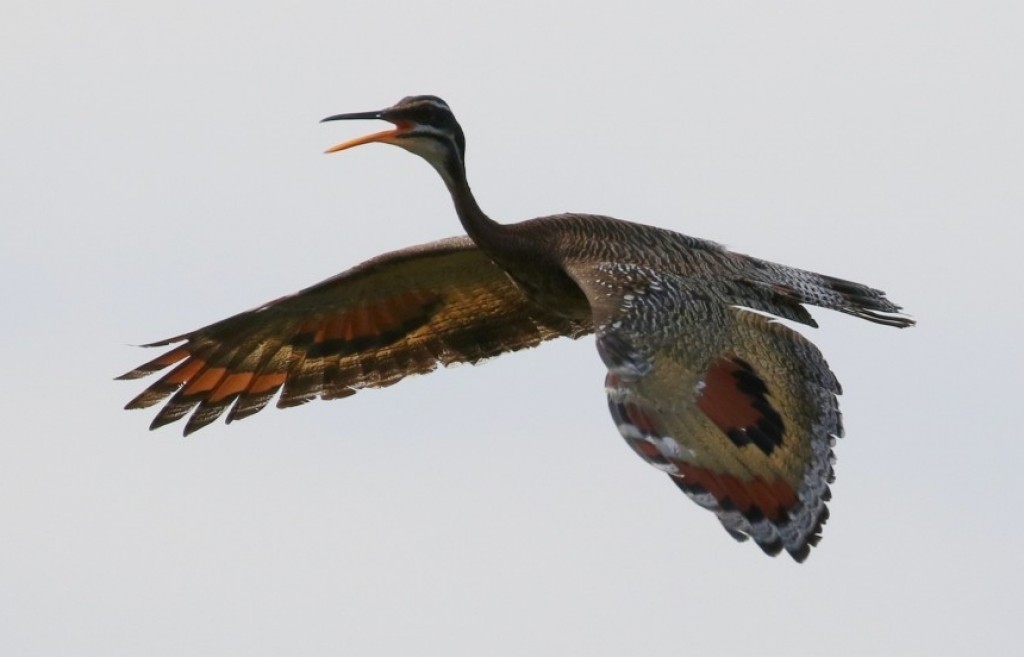Sunbittern
A species of Sunbittern Scientific name : Eurypyga helias Genus : Sunbittern
Sunbittern, A species of Sunbittern
Botanical name: Eurypyga helias
Genus: Sunbittern
Content
Description General Info
 Photo By Guyincognito , used under CC-BY-SA-4.0 /Cropped and compressed from original
Photo By Guyincognito , used under CC-BY-SA-4.0 /Cropped and compressed from original Description
The bird has a generally subdued coloration, with fine linear patterns of black, grey and brown. Its remiges however have vividly colored middle webs, which with wings fully spread show bright eyespots in red, yellow, and black. These are shown to other sunbitterns in courtship and threat displays, or used to startle potential predators. Male and female adult sunbitterns can be differentiated by small differences in the feather patterns of the throat and head. Like some other birds, the sunbittern has powder down. The sunbittern has a long and pointed bill that is black above, and a short hallux as in shorebirds and rails. In the South American subspecies found in lowlands east of the Andes, the upperparts are mainly brown, and the legs and lower mandible are orange-yellow. The two other subspecies are greyer above, and their legs and bill are sometimes redder. 
Size
48 cm
Colors
Brown
Black
Yellow
Red
Gray
White
Life Expectancy
15 years
Nest Placement
Ground
Feeding Habits
Sunbittern consumes insects, crabs, spiders, shrimps, earthworms, fish, amphibians, eels, and lizards. They exhibit bait-using behavior to lure prey, although observed only in captivity.
Habitat
The sunbittern's range extends from Guatemala to Brazil. The nominate race, E. h. helias, is found east of the Andes in lowland tropical South America, from the Orinoco basin, through the Amazon basin and Pantanal. The subspecies E. h. meridionalis, has a more restricted distribution, being found along the East Andean slope in south-central Peru, in the lower subtropical zone at altitudes of 800–1,830 m (2,620–6,000 ft). The final subspecies, E. h. major, is found at various altitudes ranging from southern Guatemala, through Central America and the Chocó to western Ecuador. This subspecies may also be present in southern Mexico. It has been traditionally reported from the Atlantic slope of Chiapas, but no specimens are known and there have been no recent records. The species is found in the humid Neotropical forests, generally with an open understorey and near rivers, streams, ponds or lagoons. 
Dite type
Omnivorous
General Info
Feeding Habits
Bird food type
Behavior
They are cryptic birds that display their large wings, that exhibits a pattern that resemble eyes, when they feel threatened. 
Distribution Area
The sunbittern's range extends from Guatemala to Brazil. The nominate race, E. h. helias, is found east of the Andes in lowland tropical South America, from the Orinoco basin, through the Amazon basin and Pantanal. The subspecies E. h. meridionalis, has a more restricted distribution, being found along the East Andean slope in south-central Peru, in the lower subtropical zone at altitudes of 800–1,830 m (2,620–6,000 ft). The final subspecies, E. h. major, is found at various altitudes ranging from southern Guatemala, through Central America and the Chocó to western Ecuador. This subspecies may also be present in southern Mexico. It has been traditionally reported from the Atlantic slope of Chiapas, but no specimens are known and there have been no recent records. The species is found in the humid Neotropical forests, generally with an open understorey and near rivers, streams, ponds or lagoons. 
Species Status
Not globally threatened.
Scientific Classification
Phylum
Chordates Class
Birds Order
Kagu, Sunbittern Family
Eurypygidae Genus
Sunbittern Species
Sunbittern